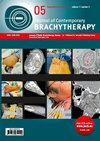Safety of high-dose-rate brachytherapy in patients with prostate cancer and inflammatory bowel disease: A case series
IF 1.1
4区 医学
Q4 ONCOLOGY
引用次数: 0
Abstract
Introduction:Inflammatory bowel disease (IBD) is a relative contraindication to external beam radiation therapy (EBRT) for prostate cancer patients due to fear of increased risk of gastrointestinal (GI) toxicity. High-dose-rate (HDR) brachytherapy, capable of minimizing radiation dose to surrounding tissues, is a feasible alternative. Given limited data, this study examined the safety profile of HDR brachytherapy in this setting.
Material and methods:
We conducted a retrospective review of patients with localized prostate cancer and IBD treated with HDR brachytherapy at the University of California San Francisco (UCSF), between 2010 and 2022. Eligibility criteria included biopsy-proven prostate cancer, no distant metastases, absence of prior pelvic radiotherapy, IBD diagnosis, and at least one follow-up visit post-treatment.
Results:
Eleven patients were included, with a median follow-up of 28.7 months. The median dose administered was 2700 cGy (range, 1500-3150 cGy) over 2 fractions (range, 1-3 fractions). Two patients also received EBRT. Rectal spacers (SpaceOAR) were applied in seven patients. All patients experienced acute genitourinary (GU) toxicity, ten of which were grade 1 and one was grade 2. Eight patients experienced late grade 1 GU toxicity, and three patients had late grade 2 GU toxicity. GI toxicities were similarly low-grade, with six grade 1 acute toxicity, no grade 2 or higher acute toxicity, six grade 1 late toxicity, and one late grade 2 GI toxicity. No grade 3 or higher acute or late GI or GU toxicities were reported.
Conclusions:
HDR brachytherapy appears to be a safe and tolerable treatment modality for patients with prostate cancer and IBD, with minimal acute and late GI and GU toxicity. These findings warrant multi-institutional validation due to small sample size.
前列腺癌合并炎症性肠病患者接受高剂量率近距离放射治疗的安全性:病例系列
导言:炎症性肠病(IBD)是前列腺癌患者接受体外射束放射治疗(EBRT)的相对禁忌症,因为患者担心胃肠道(GI)毒性风险会增加。高剂量率近距离放射治疗(HDR)能够最大限度地减少对周围组织的辐射剂量,是一种可行的替代方法。材料与方法:我们对 2010 年至 2022 年期间在加州大学旧金山分校(UCSF)接受 HDR 近距离放射治疗的局部前列腺癌和 IBD 患者进行了回顾性研究。资格标准包括经活检证实的前列腺癌、无远处转移、既往未接受盆腔放疗、IBD诊断以及至少一次治疗后随访。中位放疗剂量为2700 cGy(范围为1500-3150 cGy),分2次进行(范围为1-3次)。两名患者还接受了 EBRT 治疗。七名患者使用了直肠间隔器(SpaceOAR)。所有患者都出现了急性泌尿生殖系统(GU)毒性,其中 10 例为 1 级,1 例为 2 级。八名患者出现晚期 1 级泌尿生殖系统毒性,三名患者出现晚期 2 级泌尿生殖系统毒性。消化道毒性同样较低,6 例急性毒性为 1 级,没有 2 级或以上急性毒性,6 例晚期毒性为 1 级,1 例晚期 2 级消化道毒性。结论:对于前列腺癌和肠道疾病患者来说,HDR 近距离放射治疗似乎是一种安全、可耐受的治疗方式,其急性和晚期肠道及胃肠道毒性极低。由于样本量较小,这些研究结果需要多机构验证。
本文章由计算机程序翻译,如有差异,请以英文原文为准。
求助全文
约1分钟内获得全文
求助全文
来源期刊

Journal of Contemporary Brachytherapy
ONCOLOGY-RADIOLOGY, NUCLEAR MEDICINE & MEDICAL IMAGING
CiteScore
2.40
自引率
14.30%
发文量
54
审稿时长
16 weeks
期刊介绍:
The “Journal of Contemporary Brachytherapy” is an international and multidisciplinary journal that will publish papers of original research as well as reviews of articles. Main subjects of the journal include: clinical brachytherapy, combined modality treatment, advances in radiobiology, hyperthermia and tumour biology, as well as physical aspects relevant to brachytherapy, particularly in the field of imaging, dosimetry and radiation therapy planning. Original contributions will include experimental studies of combined modality treatment, tumor sensitization and normal tissue protection, molecular radiation biology, and clinical investigations of cancer treatment in brachytherapy. Another field of interest will be the educational part of the journal.
 求助内容:
求助内容: 应助结果提醒方式:
应助结果提醒方式:


